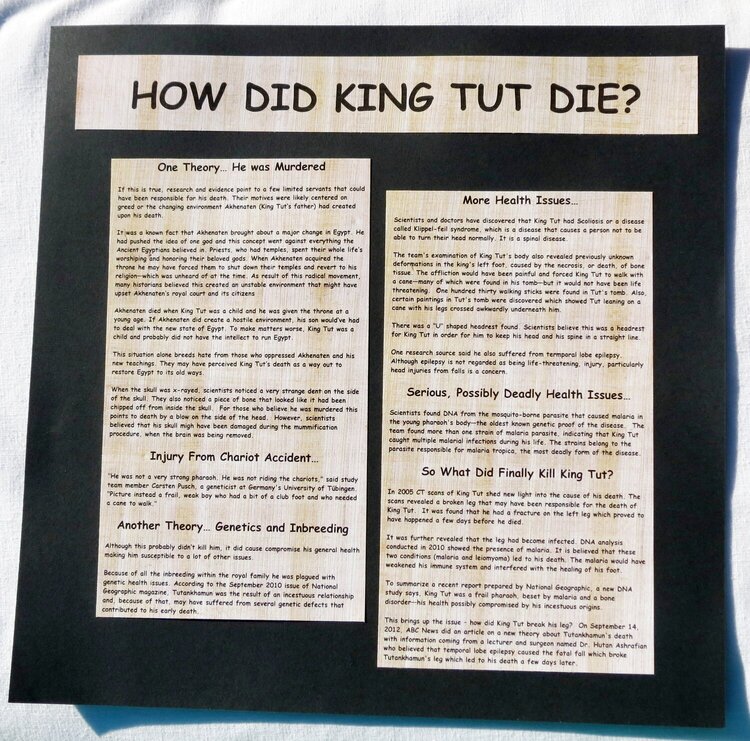EXTRA 11% OFF Orders $100+ With Code: THANKYOU


 Give a Cheer
Give a Cheer
One Theory… He was Murdered
If this is true, research and evidence point to a few limited servants that could have been responsible for his death. Their motives were likely centered on greed or the changing environment Akhenaten (King Tut's father) had created upon his death.
It was a known fact that Akhenaten brought about a major change in Egypt. He had pushed the idea of one god and this concept went against everything the Ancient Egyptians believed in. Priests, who had temples, spent their whole life's worshiping and honoring their beloved gods. When Akhenaten acquired the throne he may have forced them to shut down their temples and revert to his religion—which was unheard of at the time. As result of this radical movement, many historians believed this created an unstable environment that might have upset Akhenaten's royal court and its citizens
Akhenaten died when King Tut was a child and he was given the throne at a young age. If Akhenaten did create a hostile environment, his son would've had to deal with the new state of Egypt. To make matters worse, King Tut was a child and probably did not have the intellect to run Egypt.
This situation alone breeds hate from those who oppressed Akhenaten and his new teachings. They may have perceived King Tut's death as a way out to restore Egypt to its old ways.
When the skull was x-rayed, scientists noticed a very strange dent on the side of the skull. They also noticed a piece of bone that looked like it had been chipped off from inside the skull. For those who believe he was murdered this points to death by a blow on the side of the head. However, scientists believed that his skull might have been damaged during the mummification procedure when the brain was being removed.
Injury From Chariot Accident…
"He was not a very strong pharaoh. He was not riding the chariots," said study team member Carsten Pusch, a geneticist at Germany's University of Tübingen. "Picture instead a frail, weak boy who had a bit of a club foot and who needed a cane to walk."
Another Theory… Genetics and Inbreeding
Although this probably didn't kill him, it did cause compromise his general health making him susceptible to a lot of other issues.
Because of all the inbreeding within the royal family he was plagued with genetic health issues. According to the September 2010 issue of National Geographic magazine, Tutankhamun was the result of an incestuous relationship and, because of that, may have suffered from several genetic defects that contributed to his early death.
More Health Issues…
Scientists and doctors have discovered that King Tut had Scoliosis or a disease called Klippel-feil syndrome, which is a disease that causes a person not to be able to turn their head normally. It is a spinal disease.
The team's examination of King Tut's body also revealed previously unknown deformations in the king's left foot, caused by the necrosis, or death, of bone tissue. The affliction would have been painful and forced King Tut to walk with a cane—many of which were found in his tomb—but it would not have been life threatening. One hundred thirty walking sticks were found in Tut's tomb. Also, certain paintings in Tut's tomb were discovered which showed Tut leaning on a cane with his legs crossed awkwardly underneath him.
There was a "U" shaped headrest found. Scientists believe this was a headrest for King Tut in order for him to keep his head and his spine in a straight line.
One research source said he also suffered from termporal lobe epilepsy. Although epilepsy is not regarded as being life-threatening, injury, particularly head injuries from falls is a concern.
Serious, Possibly Deadly Health Issues…
Scientists found DNA from the mosquito-borne parasite that caused malaria in the young pharaoh's body—the oldest known genetic proof of the disease. The team found more than one strain of malaria parasite, indicating that King Tut caught multiple malarial infections during his life. The strains belong to the parasite responsible for malaria tropica, the most deadly form of the disease.
So What Did Finally Kill King Tut?
In 2005 CT scans of King Tut shed new light into the cause of his death. The scans revealed a broken leg that may have been responsible for the death of King Tut. It was found that he had a fracture on the left leg which proved to have happened a few days before he died.
It was further revealed that the leg had become infected. DNA analysis conducted in 2010 showed the presence of malaria. It is believed that these two conditions (malaria and leiomyoma) led to his death. The malaria would have weakened his immune system and interfered with the healing of his foot.
To summarize a recent report prepared by National Geographic, a new DNA study says King Tut was a frail pharaoh beset by malaria and a bone disorder—his health possibly compromised by his incestuous origins.
This brings up the issue – how did King Tut break his leg? On September 14, 2012, ABC News did an article on a new theory about Tutankhamun's death with information coming from a lecturer and surgeon named Dr. Hutan Ashrafian who believed that temporal lobe epilepsy caused the fatal fall which broke Tutankhamun's leg which led to his death a few days later.
No products have been added to this project.
Thanks for spreading positivity!
May 07, 2013
February 28, 2013
February 26, 2013
February 24, 2013
February 24, 2013
February 21, 2013
February 20, 2013
February 19, 2013
February 18, 2013
February 18, 2013
February 18, 2013
February 18, 2013
February 18, 2013
February 17, 2013
February 16, 2013
February 16, 2013
February 16, 2013
February 15, 2013
February 15, 2013
February 15, 2013
February 15, 2013
February 15, 2013